Available PhD Topics
Below you will find information about available PhD projects. Please select your topic of interest:
MPE Infrared Astronomy: Galaxy Evolution, Galactic Nuclei, and Black Holes
We take a unique approach in combining experimental and observational astrophysics - we focus on important astrophysical questions, and then build the best instruments to answer them! Our main science themes center on the formation and evolution of galaxies at redshifts between 1 and 3, and the physics of galactic nuclei and black holes across cosmic time. Key results have been the unambiguous detection of the supermassive black hole in the center of our Galaxy through stellar orbits and the first successful test of General Relativity in the vicinity of a supermassive black hole, the first substantial survey of high redshift galaxy dynamics using integral field spectroscopy, and the first studies of cold gas and far-infrared luminosities of distant massive 'normal' galaxies.
These results show samples of our research on the physics and growth of black holes in galactic nuclei, especially the Galactic Center
A key strength is that we lead world-class instrumentation developments that are driven by our astrophysical research. In the near-infrared, we have been the PIs or significantly contributed to several current instruments at the ESO VLT over the last 2 decades: SINFONI, the integral field imaging spectrometer, NACO, the diffraction limited imager, and the KMOS multi-IFU spectrograph. We were the PI Institute for the far-infrared camera/spectrometer PACS operating from 2009 to 2013 on board ESA's Herschel Space Observatory.
Currently, we are the PI-group for GRAVITY, an astrometric imager and the first second-generation instrument for the VLT interferometer. GRAVITY is now in full operation, and is a game changer for infrared interferometry, because it can routinely observe sources up to a factor 1000 more sensitive than previous interferometers. Further drastic improvements of sensitivity and sky coverage are foreseen with the GRAVITY+ project. Spectacular results from our team include testing General Relativity near the Galactic Center black hole, and kinematically resolving the broad line region in the nearby QSO 3C273, among other topics.
We are also the PI institute for the ERIS diffraction limited imager and spectrograph for the VLT (with commissioning in 2021), and the first-light instrument, MICADO, for the upcoming European Extremely Large Telescope. At longer wavelengths members of our group have actively supported the upgrade of NOEMA at IRAM.
Research areas for which we offer PhD theses are:
- Unique instrumentation concepts in high resolution astronomy – MICADO, GRAVITY+
- Exploring galaxy evolution through near-infrared to mm-wave high resolution observations of high redshift galaxies – NOEMA 3D /ERIS
- The Black Hole in the center of our Galaxy and its surrounding stellar cluster with GRAVITY and ERIS – a laboratory for understanding black holes and strong gravity –
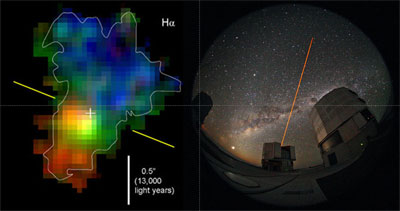
High resolution studies of galaxy evolution like the surprising detection of a massive rotating disk in the z=2.38 galaxy BzK-15504 are made possible by our active instrumentation program, for example the PARSEC laser at the ESO VLT.
MPE High Energy Astrophysics
High Energy Astrophysics addresses among the most extreme processes and regions in the Universe. Plasma with temperatures up to billions of degrees, and the interaction of highly energetic electrons with magnetic and photon fields generates high energy radiation in the X-rays and gamma rays. Studying cosmic objects in these wavebands gives insights into physical processes that often cannot be achieved when observing in other wave bands.
The High Energy Astrophysics group at MPE, comprising about 80 members, has its major scientific emphasis on the study of these processes, mostly via X-ray observations, but also extending to other wavebands. Our main astrophysical themes are: 1) Investigating physical processes including strong gravity around black holes and other compact objects
To achieve our scientific aims the group runs a major experimental program in the development and construction of X-ray instrumentation. We also develop highly specialized X-ray detectors, which including the EPIC pn-CCD camera on XMM-Newton and the eROSITA pn-CCD cameras. We are currently developing the technologies for the Athena Wide Field Imager (WFI) instrument.
We have long experience in the realization of X-ray telescopes, while whole satellite payloads are calibrated in our 130 m test facility PANTER. This engagement enabled us to build and operate for over 8 years the ROSAT observatory, and collaborate actively in all major X-ray observatory missions, especially XMM-Newton and Chandra.
The high energy group successfully launched the X-ray observatory eROSITA on July 13, 2019. The observatory is currently on its way to the Langrangian point L2 from where 8 full-sky surveys will be performed in the next 4 years. Detectors are currently commissioned so that it is expected to start with scientific observations by the end of 2019. The eROSITA X-ray all-sky survey will be a factor of 10-30 deeper than the ROSAT all-sky survey performed in the early 90s. Using optical, infrared and radio data to better interpret the X-ray results has also stimulated working in a worldwide net of astronomy collaborations.
Research fields for which PhD projects are specifically offered include:
- X-ray observations of strong gravity effects in active galactic nuclei and X-ray binaries
- Black hole growth through cosmic time and its relation to galaxy evolution
- Searches for accreting black holes in the early Universe
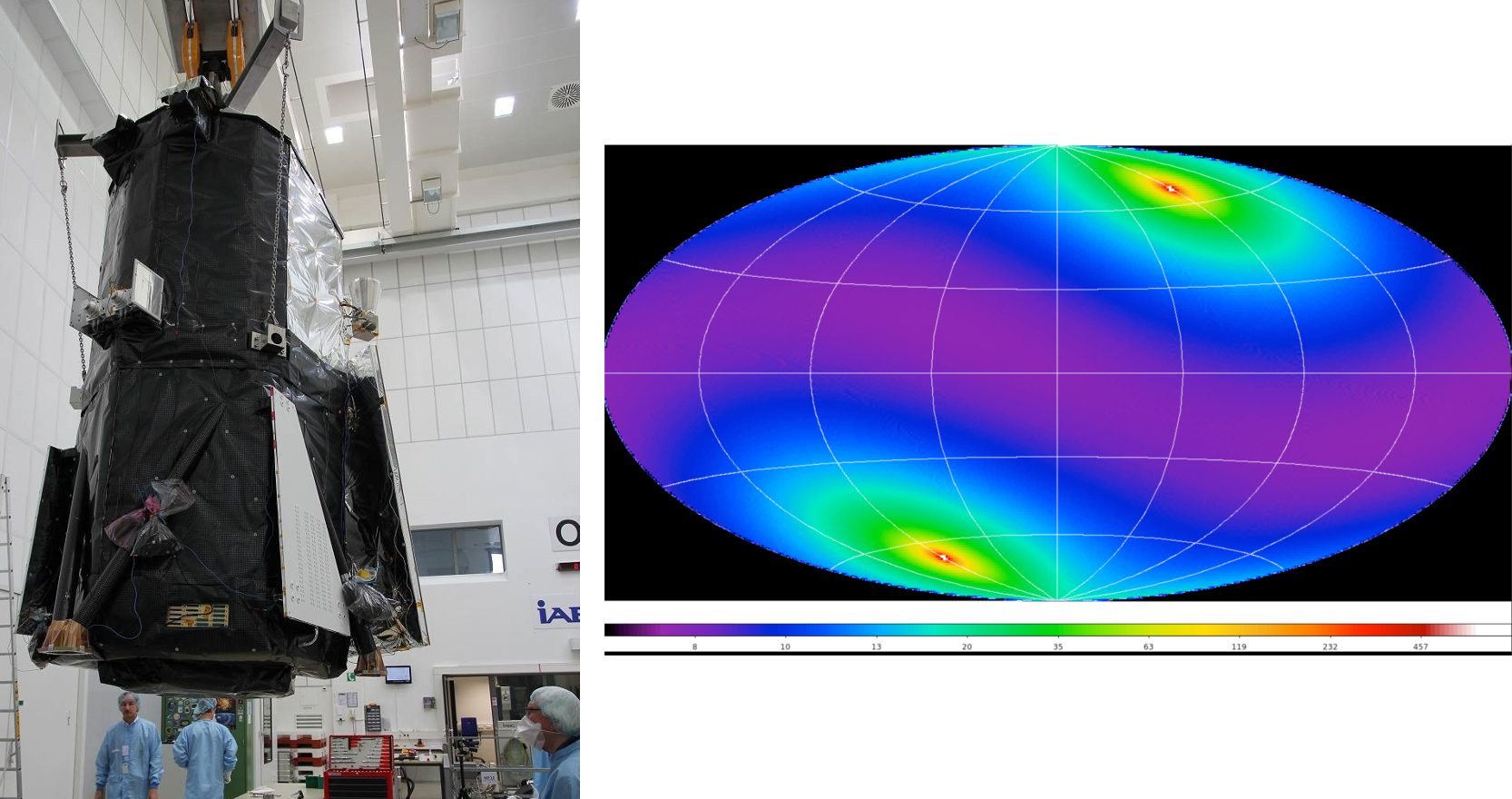
Left: eROSITA instrument during the qualification tests. Right: Planned eROSITA “cadence” map. The celestial sphere in equatorial coordinates is color-coded by the number of visits of eROSITA during the 4-years all-sky survey. The eROSITA all-sky survey is expected to provide insight on 3 million AGN and 100000 clusters.
MPE Optical and Interpretative Astronomy &
The LMU/USM - MPE extragalactic research group is a joint effort of the University Observatory of Munich (USM) and the Max Planck Institute for Extraterrestical Physics. The group is located both at the LMU/USM (see 'Extragalactic Astronomy') and at MPE. Senior group members are Prof. Ralf Bender, Dr. Maximilian Fabricius, Prof. O. Gerhard, Dr. Ulrich Hopp, P.D. Dr. Roberto P. Saglia, Dr. Ariel G. Sánchez, Dr. Stella Seitz and Dr. Jens Thomas.
The research of the group focuses on dark energy and dark matter in the Universe, on the properties of local and distant galaxies, and on extrasolar planets. The aims of our current science projects are:
- to constrain the nature of dark matter, by analysing cluster and galaxy dark matter halo profiles with strong and weak lensing in combination with dynamical and photometric information for nearby galaxies
- to derive constraints on the nature of dark energy, by studying the large-scale structure of the Universe by means of weak lensing and clustering measurements
- to understand the structure and dynamics of local and distant galaxies, their stellar populations, their formation and evolution
- to reconstruct the dark matter mass distribution and chemodynamical history of the Milky Way from the current revolutionary survey data, giving us a template for galaxy formation
- to quantify the role of black holes and dark matter in galaxies
- to search for extrasolar planets using the transit method in wide field surveys and understand their properties (mass, density, atmosphere)
We pursue these science questions with a combination of optical and near-infrared observations, theory, numerical modelling, and data interpretation.
The observational data necessary for our scientific programs come from a large variety of telescopes, primarily ESO, the Hobby-Eberly Telescope HET, the 2.7m telescope of the McDonald observatory, the USM 2m Fraunhofer telescope at the Wendelstein observatory in the Bavarian Alps and also space (HST) and survey (e.g. SDSS) telescopes. We also have guaranteed access to telescopes for providing instruments (e.g.OmegaCAM, KMOS,
We carry out studies of black holes in local galaxies without active galactic nuclei, measuring their masses through stellar dynamics. Using similar techniques we reconstruct the stellar orbital distributions and dark matter halos of dwarf and giant early-type galaxies or globular clusters. Exploiting the multiplexing capabilities of our KMOS spectrograph, we study galaxy evolution up to redshift 2.5 by observing large samples of star forming and passive galaxies.
Our group also participates with a significant role in large international surveys. Examples are the completed Baryon Oscillation Spectroscopic Survey BOSS, the on-going extended BOSS
(eBOSS) and Dark Energy Survey (DES), and future surveys such as the Hobby-Eberly Telescope Dark Energy Experiment (HETDEX) and the ESA space mission Euclid. Galaxy clustering and gravitational lensing measurements based on these data sets probe the large-scale structure of the universe with unprecedented precision, providing invaluable information on the nature of dark matter and dark energy, the growth of structure, neutrino masses and inflationary physics. The design, construction, analysis, modelling and interpretation of these data sets are some of the main activities of our group.
The numerical modelling required for our projects is based on state-of-the-art algorithms run on supercomputers. Some of these methods are developed or implemented within our group. Recent examples are Schwarzschild's orbit superposition method used for measuring black hole masses, and the NMAGIC adaptive N-body code for modelling galaxy dynamics.
This year we offer PhD projects within our group in the following science areas:
- Gravitational lensing
- Dynamical modelling galaxies
- Stellar content and structure of the Milky Way
- Cosmological analysis of galaxy clustering measurements
- Instrument development
For more details visit our homepages OPINAS or PhD-Thesis Projects.
MPE Center for Astrochemical Studies
We are an interactive group of observers, theoreticians and laboratory experimental researchers, with strong links to other national and international Institutes. Our aim is to study interstellar clouds and their physical/chemical evolution toward the formation of stars and planetary systems. On the one hand, molecular lines are used as tools to unveil the physical structure and dynamics of clouds and star/planet forming regions. On the other hand, observational and theoretical studies of molecules during cloud evolution allow us to investigate the increase in chemical complexity from the initial diffuse stages, to the dense cloud cores within which stellar systems form, to the circumstellar disks where planets are assembled, with the final aim of shedding light on our cosmic origins (cf. the Figure at the end of this section). We observe molecular lines with state-of-the-art telescopes (such as ALMA and the IRAM Plateau de Bure Interferometer / NOEMA) and we make predictions using comprehensive chemical models inclusive of surface chemistry (i.e. the chemistry occurring on the surface of dust grain particles), as well as magneto- and hydrodynamic codes coupled with simple chemistry. We started our activities in April 2014 and we are now building a high-precision molecular spectroscopy laboratory, where astrophysical important molecular ions, radicals and organic molecules will soon be studied. Laboratory experiments will provide a fundamental input to our observational and theoretical activities, as transition frequencies will be measured with high precision and the molecular structure determined. We also plan to use our experiments to refine calculations of collisional coefficients needed in radiative transfer codes, which test theories by simulating observations of dynamical-chemical model results.
We offer PhD thesis in the following areas:
- Observations: (1) From filaments to dense cores: kinematics and the importance of magnetic fields. (2) From dense cores to protoplanetary disks: physics and chemistry in the inner 1000 AU.
- Theory: (1) The effects of chemistry in magneto-hydrodynamic models of dense cloud cores. (2) The time scale for star formation by using comprehensive chemical models coupled with hydrodynamic simulations of molecular clouds.
- Laboratory: (1) Chirped pulsed experiment: setup and first light on complex organic molecules. (2) High precision molecular spectroscopy of molecular ions and radicals of astrophysical interest.
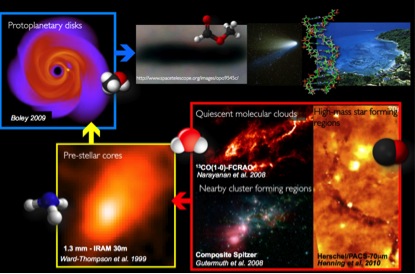
Our cosmic origins: Schematic illustration of the various phases in the process of star and planet formation, which are studied in the CAS group (from parsec-scale molecular clouds in the bottom right, to the 10,000 AU-scale of pre-stellar cores, to the 100 AU-scale of protoplanetary disks in various stages of evolution, to our Solar System). The five superposed molecules (anticlockwise from the bottom right: CO, H2O, NH3, CH3OH, HCOOCH3) are among the most common molecules observed in star forming regions. They are only five out of the about 180 (mostly organic) molecules detected in space. Interstellar molecules are the building blocks of more complex organics also found in meteorites, such as amino acids, purine and pyrimidine bases and sugars, i.e. the basic building blocks of proteins and nucleic acids (such as the deoxyribonucleic acid, DNA, in the top right) present in living beings on Earth (see Caselli &
The research of the computational astrophysics group at the USM is focussed on dynamical processes in galaxies, related to galaxy formation and evolution, the evolution of the interstellar medium and star and planet formation. Using different numerical methods and codes, coupled with special hardware connected to local PC clusters for fast computations we explore the complex non-linear evolution of gas in galaxies and its condensation into dense molecular clouds and stars. We explore the collapse of protostellar clumps and cores, the formation of protostellar disks and their condensation into planets. On larger scales we investigate galaxy-galaxy interactions including dark matter, stars and gas and study the morphological transitions of galaxies and the origin of their spheroidal components. Research fields for which PhD projects are offered: Hot Stars cover sub-groups of objects in different parts of the HR diagram and at different evolutionary stages. The most important sub-groups are massive O/B Stars, Central Stars of Planetary Nebulae, and Supernovae. All these objects have in common that they are characterized by high radiation energy densities and expanding atmospheres. Due to these properties, the state of the outermost parts of these objects is characterized by non-equilibrium thermodynamics and radiation hydrodynamics. The USM Hot Star group is experienced in the corresponding theory of stellar atmospheres, and in model simulations and the computation of realistic synthetic spectra for these astrophysically important objects. Specific topics address the relevance of Hot Stars for current astronomical research: Research fields for which PhD projects are offered: The main focus of the working group thus is to develop diagnostic techniques in order to extract the complete physical stellar information from the spectra at all wavelength ranges. We explore topics from the formation of planets and single stars to larger scale star and cluster formation by means of numerical and theoretical investigations. We use state-of-the-art numerical tools and develop new algorithms in-house in order to tackle problems of hydrodynamics, planet & disk interaction, planetesimal formation, dust & gas disk evolution, radiation transport in complex evolving hydrodynamical systems, and others. Some of the latest highlights from the groups involve PhD projects can be offered in the context of these research topics listed above. For more details visit the homepages of Prof. Dr. B. Ercolano and Prof. Dr. T. Birnstiel Left: Bubbles and pillars sculpted by HII regions in a turbulent molecular cloud. Snapshot of the neutral gas from a Smooth Particle Hydrodynamic simulation performed by Jim Dale. Right: A Jupiter mass planet interacting with the gas (gray scale) and dust of the accretion disk. Large particles (blue, >1mm) collect in a pressure maximum outside the planet orbit and also at the center of a vortex. Small dust grains (red, 7 . Within the Chair for Cosmology and Structure Formation at LMU, we are pursuing studies in cosmology and the formation and evolution of large scale structures in the Universe. Our work is at the interface of observation and theory, where we seek to bring together new observational constraints with state of the art hydrodynamical simulations of structure formation. In our recent papers we have presented forefront results in topics such as the nature of the cosmic acceleration, the sum of the neutrino masses, halo mass constraints from weak lensing studies of clusters, and the cosmic history of AGN feedback and its effects on the large scale structure. Most of our ongoing structure formation studies focus on clusters of galaxies, the most massive collapsed structures in the universe. The primary research interest of our group are photometric and spectroscopic cosmological surveys as a tool to study large structures in the Universe, such as galaxies, clusters of galaxies and even larger-scale matter density fluctuations. The census and evolution of these structures is interesting in its own right, but it can also give us a better understanding of two of the greatest mysteries of modern physics, dark matter and dark energy. To reach that goal, we need to develop new methods in statistics and data analysis, particularly artificial intelligence, for the extraction of reliable and powerful information from observations. A methodological focus is the use of gravitational lensing, the accurate measurements of galaxy redshifts, and innovative ways of combining data from different types of observations, including observing programs designed within our group. Our overarching goal is a model and a quantitative understanding of the cosmos as a whole, and the large structures that form inside of it. Our group is currently relocating from Stanford University / SLAC National Accelerator Laboratory to LMU's University Observatory for start dates in Fall 2021. We collaborate globally with observers, data scientists, and theorists from the Dark Energy Survey Collaboration, the Vera C. Rubin Legacy Survey of Space and Time, the Euclid project, the Dark Energy Spectroscopic Instrument collaboration, and 4MOST. Four examples of possible PhD topics within our group are given below: Top left: The largest map of matter density made with weak gravitational yet, from three years of Dark Energy Survey observations. Top right: Deep image of the galaxy cluster MACS J0416.1-2403. Bottom: The site of the future Vera C. Rubin Observatory as seen from within the dome of the Blanco Telescope on Cerro Tololo, Chile. The MPA Cosmology group is interested in the structure, evolution and material content of our Universe. PhD positions can be offered in any (or a combination) of the following scientific topics which are currently under active study: Group members use a mixture of pure theory, high-performance numerical simulations, data interpretation, and direct observations to address these questions. The group is one of the principal nodes of the international Virgo Supercomputing Consortium which has carried out many of the largest cosmological simulations ever completed. It is a Partner in the Sloan Digital Sky Survey IV and PhD projects are availabe to use integral field unit (IFU) spectroscopy of 10,000 nearby galaxies to study stellar populations, kinematics and gas and star-forming properties of galactic bulges, disks and halos. With the MPA High Energy group it is the German centre for the Planck mission which is currently mapping the microwave background radiation. It has built a remote station for the radio interferometer Low Frequency Array. A slice through the dark matter distribution of the Millennium-XXL simulation, focusing on the most massive collapsed structure present a z=0. The Millennium-XXL, the largest simulation of cosmic structure formation ever carried out, follows the gravitational interaction of more than 300 billion dark matter particles on a cubical region of 4200 Mpc across. This calculation is used to study the very large-scale distribution of galaxies and its implications for Dark Energy measurements. The area of interests of the MPA High Energy Astrophysics group can be broadly outlined as physical processes and interaction of matter and radiation under extreme astrophysical conditions. The objects where these processes are investigated include the Universe as a whole, clusters of galaxies, supermassive black holes and jets in AGN, accreting black holes and neutron stars in X-ray binaries, Gamma-ray bursts and the Cosmic Microwave Background. Similarities in the underlying physical processes bind these diverse subjects together. A special focus of the work is accretion onto compact objects (black holes, neutron stars and white dwarfs). This includes theories for the hydrodynamics of the accretion process and the origin of the energetic radiation. Examples are detailed theories for the boundary layer around accreting neutron stars, and the theory of Comptonization and it's applications. In addition members of the group are closely involved with interpretation of the observational signatures of accreting black holes and neutron stars, the study of X-ray emission from the clusters of galaxies, relic radio sources, theories for the central engines of Gamma-ray Bursts, the evolution of binary, triple, and higher-order multiplicity stars, and the behavior of magnetic fields in a wide range of astrophysical environments. Likewise, this research group has interests in the study of the interaction of CMB photons with matter at different evolutionary epochs of our universe. These include the cosmological recombination, the end of the Dark Ages/beginning of reionization, and the late accelerated expansion phase seeded by a cosmological constant or any sort of Dark Energy. Particular emphasis is paid on the characterization of the CMB spectrum generated during recombination, the interaction of the CMB with the heavy elements synthesized by the first stars, and the secondary anisotropies introduced by newly ionized bubbles, galaxy groups and clusters during the ntermediate and late ages of our universe. The group can host PhD students in any (or a combination of) these areas. One of the key elements of the group's approach is to complement the theoretical advancement of the field with state-of-the-art data analysis of the experimental data. The group is actively using the data from the RXTE, CHANDRA, XMM-Newton, INTEGRAL, Swift and WMAP observatories. The group also provides scientific support for future missions that will lead to substantial progress in high resolution X-ray spectroscopy and microsecond timing. Research fields for which PhD projects are offered: Information field theory (IFT) is information theory, the logic of reasoning under uncertainty, applied to fields. A field can be any quantity defined over some space, e.g. the air temperature over Europe, the magnetic field strength in the Milky Way, or the matter density in the Universe. IFT describes how data and knowledge can be used to infer field properties. Mathematically it is a statistical field theory and exploits many of the tools developed for such. Practically, it is a framework for signal processing and image reconstruction. Research on IFT requires an excellent mathematical training and/or good programming skills. More information can be found at the IFT group page and the IFT resources pages. Examples of IFT applications. Leftmost: An estimator for primordial non-Gaussianity expressed in Feynman diagrams superimpose on an image of the cosmic microwave background (CMB). Middle-left: Reconstructed all-sky Faraday effect, showing the Galactic magnetic field. Middle-right: Reconstructed primordial gravitational potential at the location of the CMB last scattering surface. Rightmost: The gamma-ray sky reconstructed from data of the Fermi satellite in the energy range 0.5-300 GeV. The MPA Supernovae group is a world-leader in modelling the violent deaths of stars in the form of supernovae and studying how such explosions produce the chemical elements, generate gravitational waves or can be used as reliable cosmic distance indicators. Massive stars end their lives in core collapse supernovae when the star has run out of nuclear fuel in the interior. In some cases the explosion following the initial collapse can lead to particularly energetic hypernovae or gamma-ray bursts. Another type of supernovae occurs in binary systems involving white dwarfs, the compact remnants of less massive stars. These thermonuclear supernovae explosion can either be triggered by accretion of material from a companion star or during the merger of two white dwarfs. The MPA group specializes in performing realistic multi-dimensional hydrodynamical supercomputer simulations of the different types of supernovae and gamma-ray bursts, which takes into account detailed microphysics such as turbulent flame propagation, neutrino transfer, magnetic fields and special and general relativistic effects. The supernova models are also used to predict the emergent spectrum to compare with observations. Most of the work within the group is theoretical/computational in nature but more recently the group has lead several observational programs aimed at understanding the physics of supernovae. The group has a long track-record of developing novel and sophisticated numerical methods to enable the extremely computing-intensive hydrodynamical simulations. The group has excellent access to powerful parallel supercomputers and is engaged in two long term Collaborative Research Centers of the German Science Foundation (DFG) on Gravitational Wave Astronomy and on The Dark Universe. It also actively participates in the Excellence cluster on Origin and Structure of the Universe involving MPA, MPE, MPP, ESO, LMU and TUM. Research fields for which PhD projects are offered: Left: A snapshot from a 3D simulation of a core collaps supernova,which demonstrates the complex hydrodynamical velocity field and neutrino heating during the earliest phases of the collapse prior to the final explosion. Right: A simulation of a thermonuclear supernova (SNe type Ia), which shows the 3D structure of the thermonuclear burning front in blue incinerating the white dwarf. The MPA Stellar Astrophysics aims at understanding the physics of stars, providing theoretical stellar models, and using stars as probes of the cosmos, for example for the evolution of galaxies. An important aspect for this work is the study of the origin of the elements -- when, where and how the different chemical elements were produced in the Universe. Essentially all elements have been forged by nuclear reactions in the fiery interiors of stars and MPA has for decades been a world-leader in simulating stellar evolution and nucleosynthesis. Much of the work has focussed on understanding low- and intermediate mass stars and testing the models by means of helio- and asteroseismology. The stellar modelling within the group concentrates on understanding better the physics of stars, since only then nucleosynthesis, the ages of stars, their masses, and in consequence even the evolution of galaxies can only be deciphered with confidence. The focus of our attention lies on improving the treatment of convection in stars of all masses and evolutionary stages, and to provide accurate and reliable models for stars observed by asteroseismology mission. We are actively participating in the analysis and modelling of COROT and KEPLER objects. Research fields for which PhD projects are offered: A small but representative volume of the stellar atmosphere is simulated by computing the convective and radiative energy transport. The 3D geometry of the atmospheric structure and the velocity field and their time-evolution can thereby be calculated and used to predict the emergent stellar spectrum. The research activities at ESO focus on optical, infrared and millimeter wave astronomy using mainly ground-based facilities at ESO observatories in Chile. In addition to optical and infrared imaging and spectroscopy ESO astronomers are actively involved in the development and utilization of high-spatial resolution techniques such as adaptive optics or interferometry. Beyond these specific topics, the scientific expertise at ESO in fact covers all major areas of astrophysics, including observational astronomy, modelling and numerical simulations. Research interests of ESO science staff range from the Solar system to the studies of the solar neighbourhood (extrasolar planets, evolved stars, star formation), interstellar medium, Galactic structure, the local universe (Local Group and beyond) and cosmology (galaxy clusters, Gamma-ray bursts, dark matter, lensing). The complete list of PhD topic offered at ESO for all research fields is available at ESO PhD-Topics. More details on science activities at ESO are available at ESO Science. VLT/ISAAC near-infrared image of the Galactic giant HII region NGC 3603 with its central starburst cluster. Stars with masses between 0.1 and 120 solar masses formed simultaneously in the cluster. Corporate social responsibility reporting My research specialism is corporate social responsibility (CSR) reporting (social and environmental accounting, sustainability disclosure, corporate social and environmental responsibility). I welcome PhD applicants interested in researching CSR reporting and particularly: organisational motivations for CSR reporting
Economics (only two topics are listed out here, but there is a link below to a separate page devoted to Economics PhD topics) Corporate finance and the political environment This project aims at analysing whether firms&rsquo
Potential applicants with interest on this topic should contact me for further details. International trade in relation to Brexit Our Trade Realignment And Negotiation Strategy Impact Team (TRANSIT) is multidisciplinary group of researchers within the SBE, involved or potentially involved in policy analysis and advice to industry in the aftermath of Brexit. The Brexit context has brought these areas together, leading to a potential creative overlap of these disciplines. Critically, we are already engaged in funded and non-funded work in these areas. Our team builds on the following areas of existing SBE/LU London expertise: In all of these areas, Loughborough already has a tradition of academically strong research, as demonstrated by academic publications, conferences and grants. We would be happy to discuss proposals (in the areas listed above or any combination of the above), particularly where we can relate these to UK policymakers&rsquo
I am available to supervise PhD students interested in topics in organization studies, Int.HRM and employment relations that include, for instance: Management Science and Operations Revenue Management and Pricing Revenue management concerns the allocation of limited and perishable products/services (such as aeroplane seats, hotel rooms, rental cars, etc ) among customers from multiple market segments. Apart from booking controls, dynamic pricing is another important lever to manage customer demand so as to maximise the overall revenue and increase utilisation. The staff members in the MSO group have rich research experience in revenue management, with applications particularly in car rental and car (ride) sharing, airline and telecommunications, and container leasing. We welcome PhD applicants interested in researching any aspect in revenue management and in any industries. We offer three levels of Ph.D. dissertation topic services based on area of your interest, employers want, supervisors already know, & research papers. We offer Topic selection for Management, Life Science, arts, social science and health, Biological and Medical Sciences and much more. The topic itself would cover key areas such as research problem or area, study design, target population and expected the outcome. The dissertation Topics are chosen based on the research gap and other future recommendations proposed by previous researchers. As we understood that title should reflect the problem, questions, research area of the study, findings, study design, ethnicity and place of the study. Literature Review & identify the problem statement The goal and research objectives have proposed which would be developed based on the comprehensive literature review and identify the problem statement. We use a wide range of information to discover the topic including statistics, news reports, textbooks, historical information and of course recent peer-reviewed scholarly articles from the peer-reviewed journals. Proposed Methodology & Expected Outcome Literature review plays a significant role in your dissertation so we provided the latest articles published in the proposed area and identified the problem as well as proposed methodology that would include qualitative or quantitative, research design, data collection methods target population, tools used and finally expected outcome. To support our argument, we offer detailed references lists and bibliography. Marketing management is one of the best-preferred topics for a Ph.D. in Management. Every year thousands of applicants want to peruse the Ph.D. in Marketing Management. Marketing is a topic which changes every time and it depends upon various aspect as the geopolitical issues, new technology, consumer behavior, consumer perception. production diversification etc. In this article, we will discuss some of the trending topics for the Ph.D. in Marketing. This will also make you understand the process to find and some tips and tricks from someone who has a good amount of experience. Here are some of the latest and trending topics. Many Ph.D. students appear to start their project with over-ambitious topics but the important thing is, keep the topic to-the-point and resume to one central research question. Before taking the decision to finalize one topic one must start working on different topics and make sure that such a topic is new and no one else worked on it. So here are some of the topics you can work on to find a good topic for your Ph.D. Comment below if there are any current Research topics in marketing for Ph.D. LMU/USM Computational Astrophysics
LMU/USM Stellar Astrophysics - Expanding Atmospheres of Hot Stars
LMU/USM Computational Star and Planet Formation Groups
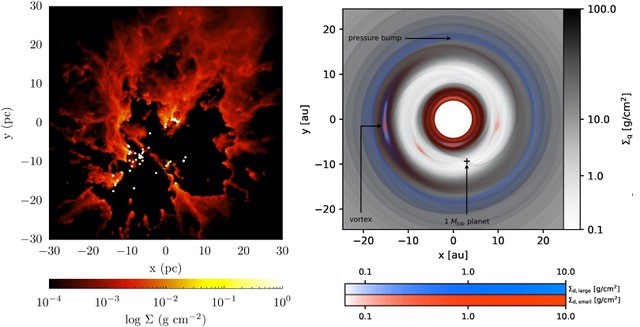
LMU/USM Cosmology and Structure Formation
Our recent analyses have focused on galaxy cluster populations identified through the Sunyaev-Zel’dovich effect by the South Pole Telescope (SPT), optically selected clusters identified within the Dark Energy Survey (DES) and X-ray selected clusters identified through the ROSAT All Sky Survey. With the successful launch of eROSITA in summer 2019, our focus will now turn to the eROSITA cluster and group sample. We are also actively preparing for the ESA Euclid mission and for the LSST ground based survey, and we are participating in the scientific exploitation of radio data from the SKA precursor array MeerKAT.
In this IMPRS round, we will be searching for students to take a leading role in the following areas:
LMU/USM Astrophysics, Cosmology, and Artificial Intelligence Group
What do we talk about when we talk about galaxies? Large observational programs like the Dark Energy Survey, the Legacy Survey of Space and Time, Euclid, DESI, and 4MOST, are now and over the next decade gathering data on galaxy samples of unprecedented size. What can we learn about the true underlying distribution of galaxy properties from these photometric and spectroscopic observations? What is the statistical connection of redshifts, masses, biographies, and spectral energy distributions of galaxies? In this project, you will build upon existing artificial intelligence methodology to categorize galaxies to incorporate future survey data and extend and test the modeling of distributions and evolutions of the physical properties of galaxy samples.
Are the large-scale structures present in the cosmos today, and those present a few billion years ago, consistent with primordial fluctuations that grew under the laws of General Relativity in a Universe filled with mostly vacuum energy and cold dark matter? It turns out this question can be answered much more stringently if we are able to use features of density fluctuations beyond its variance alone, for instance with statistics of the full PDF of matter density. In this project, you will develop techniques to measure and model these non-Gaussian density fluctuations and apply them to the latest data sets from the Dark Energy Survey, the Legacy Survey of Space and Time, Euclid, and spectroscopic surveys.
The whole is sometimes more than the sum of its parts. By statistically combining imaging data, collected by current and soon-to-start astronomical surveys, with information at other wavelengths – e.g. the cosmic microwave background, gamma-rays, or spectroscopy – we can often gain insights into astrophysical systems and the physics of the cosmos as a whole that no data set on its own would allow. In this project, you will explore connections of the latest imaging data set, the Dark Energy Survey, with such external information, and at the same time help prepare for the next generation of cross-survey discoveries.
What's in an image? How do the measurements of faint galaxies we make on their intrinsically noisy, barely resolved images relate to their true features? How can we make statistically powerful and systematically robust statements about the cosmos from analyzing them? In this project, you will go all the way from pixels to cosmology, utilizing a combination of image simulations, state-of-the-art image processing techniques, Bayesian statistics, and artificial intelligence, to underpin the cosmological insights DES, LSST and Euclid are trying to gain from analyzing the largest, deepest, sharpest images of the sky ever taken with a rigorous statistical understanding of the data they collect.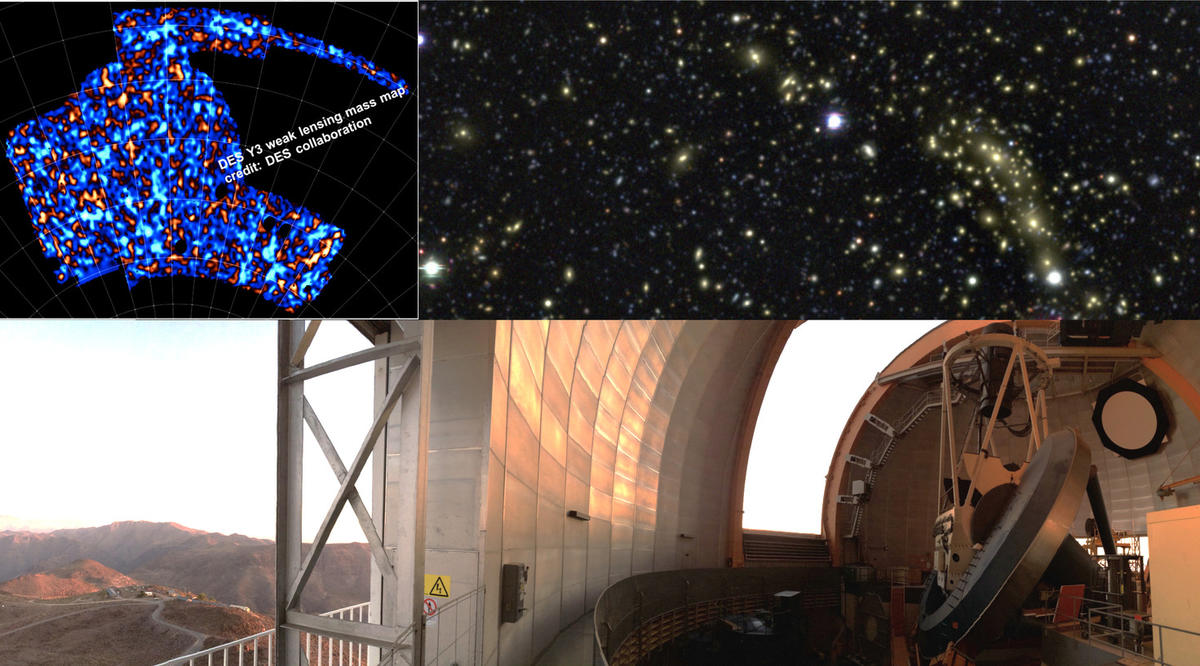
MPA Extragalactic Astrophysics and Cosmology
its chemical enrichment, its interaction with galaxies and AGNMPA High Energy Astrophysics
recombination, reionization and the late stages of our universeMPA Information Field Theory

MPA Supernovae
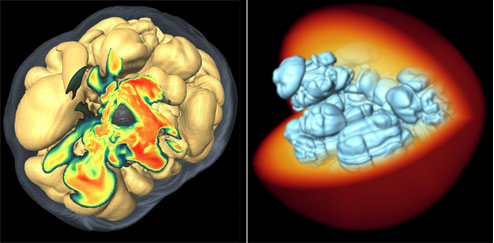
MPA Stellar Astrophysics
Astrophysics at ESO

Current list of unfunded PhD topics - listed by discipline group
Service description
Services Available
Connect with our domain-matter expertise across the globe
Topic Speaks about Your Research

Outstanding PhD Dissertation Topic Selection Features
Well-Conceptualized & Precise Ph.D. Topic Speaks about Your Research
Research topics in Marketing for PhD
List of research topics in Marketing Management
Related Posts

How to publish in Scopus indexed journal
Emerald Publishing collaborated with Sri Lanka Institute of Marketing for launching a new journal
In this article, we will discuss some of the trending topics for the Ph.D. in Marketing.
